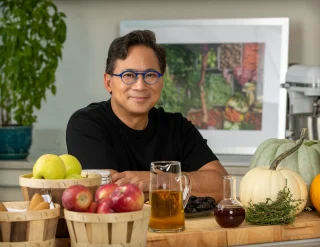The world is experiencing an epidemic of chronic diseases, and one of the major culprits is diet. Poor food choices are fueling the fire of poor health. If longevity is what you have in mind, then you need to take your food choices seriously. Make food your medicine. Choose it wisely.
A Food Discovery Journey Starts With You
The wellness landscape can be noisy. There are so many – and sometimes totally conflicting – diets being touted as the next best health thing. Eat this! Don’t eat that! It never ends.
Scientists can find objective pros and cons to every diet by assessing the biomarkers of people in their research (measurable signs that indicate what’s happening in your body, such as blood pressure levels). But what you should be doing is figuring out which one fits you.
This is where the concept of biohacking comes in.
Self-experimentation
Biohacking is a “do-it-yourself” approach to health that combines data from areas of human biology and nutrigenomics, with self-experimentation. Biohackers recognize the “participant diversity” limitations that can come from research on different wellness approaches. So, they test these methods on themselves. That way, they can tune into exactly what their body needs to perform well.
“Self-experimentation measures many things at once. Without trying, we notice our mood, clarity of thought, sleepiness, sleep quality, coordination, hunger, thirst, our digestion, how our joints feel, and so on. A conventional experiment measures far less,” suggests Seth Roberts, author of the 2010 manuscript The Unreasonable Effectiveness of My Self-Experimentation.
Some go to extremes, such as Bryan Johnson, the ultra-wealthy biohacker who invests around $2 million a year on longevity programmes to keep him from dying. But taking a look at your diet and lifestyle doesn’t need to break the bank, and it can be done in increments, to help you to better understand and control your health.
Your genes will help instruct your choices
Your DNA is a unique instruction manual. It can reveal a lot about you and what you need to stay healthy and alive. It can reveal the food interactions that are unique to your body, any genetic predispositions to diseases, as well as the areas of your health needing special attention.
So, it’s hardly surprising that people are looking to nutrigenomics for answers.
Do genes rule us?
Research indicates that your genes can partly influence your dietary patterns and palate for certain foods. Your sweet tooth, tendency to snack or aversion to broccoli may be inherited.
Drinking up to two glasses of red wine per day is thought to contribute to the longevity of the inhabitants of Sardinia. However, Sardinians have been found to possess a genetic variant of the bitter taste receptor gene, which makes them perceive the bitterness in red wine less.
Of course, environment also plays a role. For instance, someone with a predisposition for sugary foods will feel more drawn to pastries than someone without it, if their environment, such as stress at work or living near a bakery, stimulates the craving.
You DNA never changes
Knowing the genetic element to your food tendencies is empowering, because it helps you to understand why you may be driven to eat in a certain way. This can make you think twice about what food you reach for when hunger strikes, and take control, through dietary and lifestyle interventions.
“Your DNA results will always be the same – but we have the power to turn our genes on or off, resulting in better health outcomes,” explains Bernice Venter, a registered dietitian at DNAlysis.
“Some individuals may have genetic predispositions to gluten or lactose intolerance, influencing gut health and, therefore, affecting mood. In other DNA tests, we may pick up some individuals who are predisposed to certain mood disorders. So, we focus our attention on maintaining good gut health to support these genes, thus managing these mood disorders.”
Whole, unprocessed and plant-rich foods can effectively turn off illness-promoting genes and turn on health-boosting ones. So, giving your pantry and fridge a plant-inspired revamp is a good place to start.
Eat more healthy plants
Well-known research by American National Geographic Fellow and New York Times-bestselling author Dan Buettner on “Blue Zones”, geographic areas of the world where inhabitants are living longer than the average, points to a simple fact: 95% of centenarians follow a plant-based diet. Of course many eat protein, but it tends to be white meat and leaner choices of protein. There are other factors that contribute to their longevity, like exercise, environment, genes and community. However, make no mistake food plays a very powerful role in health outcomes.
Dr William Li, a renowned physician, scientist and author of the book Eat to Beat Disease, claims scientific proof to vouch for the body’s ability to heal itself when nourished with good plant foods.
Li hopes not only to help people to stay as healthy as possible, but also to prevent them from falling into a situation where they’re dependent on medications forever.
Prevention is better than cure
Following the successful development of more than 40 new treatments for chronic health conditions, including cancer, heart disease and vision loss, he wondered whether these ailments could be avoided from the outset.

Dr William Li
“We’re cleaning up the traffic accident on the highway, as opposed to preventing the accident. It led me to ask whether we could do something better by preventing disease in the first place. What I realized is that, if we’re going to talk about prevention, we can’t talk about drugs. We need to talk about something safe, accessible and inexpensive that everyone can relate to. That’s how I came about conducting food research,” he says.
The 5 Defense Systems
According to research published in the BMJ medical journal, a substandard diet surpasses tobacco as a contributor to one in every five deaths across the globe.
It’s often said that the human body is like a car: both have many intricate systems, with interrelated parts, that perform specific jobs to keep things in order.
Dr. Li says the body’s maintenance relies on the activation of its five defense systems:
- Angiogenesis,
- Regeneration,
- Microbiome,
- DNA protection and
- Immunity.
Fundamentally, health is not just the absence of disease; it’s the result of the stimulation of our body’s defense systems. Like the car, it would make sense to keep your bio-vehicle running smoothly by feeding its systems the right oil.
Li believes our power comes in the form of plant-based food. In his book Eat to Beat Disease, he lists over 200 evidence-informed foods that enhance one or more of the defense systems.
Where your food comes from matters!
Many scientific studies confirm that the quality of the nutrients of today’s crops don’t align with that of those of the crops grown decades ago. Many fruits, vegetables and grains produced today have shown a decline in nutrients such as riboflavin (vitamin B2) and ascorbic acid (vitamin C), both widely studied for their anti-aging effects. Furthermore, many harvests today are presenting low levels of protein, phosphorous, calcium and iron.
These deficiencies can result in an imbalance of “good” and “bad” bacteria in the gut, which, if left untreated, can lead to chronic diseases such as inflammatory bowel disease (IBD), obesity and cancer.
To alleviate this dietary dilemma, we need to become more mindful of and selective about who grows our food.
Buy or grow food that is grown through regenerative farming
It appears from the research that the centenarians living in the Blue Zones either produce their own food or source it locally. So, if we want to thrive, with a healthy gut, we can either invest in vegetable gardens or rely on local farmers who take the time to replenish the nutrients in the soil, through regenerative farming.
“The carrots that our grandparents ate are not the same as the carrots we eat now, and the result is sickness that afflicts the human species”, says Angus McIntosh, founder of Farmer Angus, one of two grass-fed, pasture-reared beef producers in the Western Cape.
According to McIntosh, most of the produce we see in supermarkets today comes from soil that has lost its integrity. The soil is often plowed, fumigated and finished off with artificial fertilizers unfit for human consumption.

Angus McIntosh
Food products that create an illusion of health
It’s equally important to know what’s in packaged and pre-made food. Shopping is often a rushed exercise – even when we’re after healthy options. This is because time is limited and nutrition labels are complicated. So, we base our decisions on the price, and the health claims on the packaging.
Food manufacturers often make health assertions without the facts behind them (such as “low-calorie”, “low in sugar”, “high in fiber”), to create the impression that we’re buying a product that is good for us when, really, it’s not. This is where reading the finer details of ingredients becomes an essential part of grocery shopping.
Currently, experts estimate that almost 80% of the foods we have on our supermarket shelves are either processed or ultra-processed. This food is cheap, ready to eat, has undergone various chemical processes to make it addictive, [and] often contains high levels of salt, sugar, saturated fat and other additives.
Cut back on the food volume
Large bodies of research constantly confirm that calorie restriction is a pivotal player in the quest to live long and well. A recent study published online by Nature Aging established that reducing dietary energy supply lessened DNA damage associated with aging, and promoted longevity in healthy adults.
Some believe intermittent fasting removes what can be a grueling element of calorie restriction: calculating energy intake.
A paper titled Fasting or Caloric Restriction for Healthy Aging, published online in 2013 by the National Library of Medicine, suggested that calorie restriction and intermittent fasting trigger similar biological pathways regarding aging.
Fasting and calorie restriction
Generally, traditional diets are rooted in what to eat, while intermittent fasting focuses on when to eat. You start by allocating a time window to healthy eating, and then one to calorie restriction. Then, you rotate between them. Of course, you should consult with a doctor before attempting any long fasts.
Calorie restriction and fasting both place mild stress on the body, which compels the cells to adapt. Informed of a change in the availability of external nutrients, the nutrient-signaling pathways in your cells will rely on their backup plan to ensure cells remain healthy and balanced: they activate mechanisms to mobilize internal nutrient stores within the cells. One such mechanism is called “autophagy”, where a cell, essentially, eats itself. This natural system is crucial in cell survival – it’s your body’s way of deep-cleaning itself by either recycling or removing old and damaged cells.
Eating less is more!
A 2019 journal titled The Hallmarks of Aging: An Autophagic Perspective, published online by the National Library of Medicine, indicates that autophagy declines with age, and its dysfunction can worsen age-associated diseases, such as cancer.
Your calorie-cutting exercise could also be made simpler by not eating from large plates, which heighten your portion distortion. The size of your plate can trick you into overserving yourself.
According to researchers from the University of Cambridge, individuals have been found to eat up to 527 more calories per day in the US and 279 in the UK. Rather opt for a smaller plate at mealtimes, covering half of it with veggies, and accompanying it with a lean source of protein.
Or you can adopt the principle of hara hachi bu, or “eat until 80% full”, a practise of the centenarians of Okinawa, Japan (one of the Blue Zones). It’s their belief that, if you slow down your pace of eating, eat mindfully and stop when you’re 80% full, you’ll feel greater satisfaction.
The bottom line
If you plan to live longer in good health, you’ll need to take a long, hard look at your food choices. Harness your own well power by making room for more plants in your kitchen. Look to your DNA for answers, and practice more conscious consumerism by buying organic, healthier and ethical products. And it wouldn’t hurt to buy a set of smaller dinner plates either.
Main photo credit: Gisèle WERTHEIM AYMéS



![women [longevity live]](https://longevitylive.com/wp-content/uploads/2020/01/photo-of-women-walking-down-the-street-1116984-100x100.jpg)










